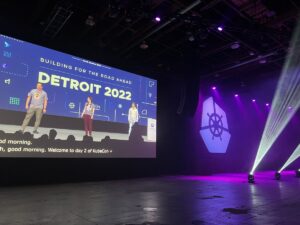The cloud native ecosystem is currently going through its own kind of industrial revolution, so it seemed fitting that the Cloud Native Computing Foundation held its blockbuster open-source KubeCon + CloudNativeCon North America 2022 event this week in Detroit, where the world’s first auto assembly line was set in motion over a century ago.
Much like the automotive industry later refined its supply chain by allowing different models to be built atop common platforms, enterprises that are successfully delivering industrial-strength cloud native applications are doing so with a platform strategy to ease Kubernetes adoption constraints for DevSecOps teams.
Platform-centric thinking
If there was one big takeaway this year, it would be the re-emergence of the platform paradigm in cloud-native clothing.
By this pattern, distributed individuals, operators and dev teams who once relied on self-learning and trial-and-error approaches to roll their own microservices architectures should instead lean on an expert platform team that can readily package approved “golden state” environments of Kubernetes clusters for them – with scaling, networking and security settings optimized for the target application and infrastructure.
In the keynotes, Shatarupa Nandi, senior director of engineering for VMware Inc.’s Tanzu, demonstrated how the newly sandboxed Carvel project advances packing capabilities for platform teams that still want to maintain governance even in self-service scenarios.
Autonomous vehicle startup Cruise discussed how it stamped out some 75 multitenant k8s environments for its cross-functional design and dev teams using Crossplane and Helm, with automatic configuration changes. An additional highlight was a cartoony “Rainbows-as-a-Service” live demo featuring a heroic platform team that reduced developer buildpack provisioning to one function deploy call to an API.
“Platform engineering is really hot right now in the cloud native space because it’s a natural extension of self-service DevOps provisioning and GitOps pipelines,” said Asanka Abeysinghe, chief technology evangelist at WSO2 LLC. The open-source firm was there demonstrating new bring-your-own-container packaging and deployment portal capabilities within its Choreo development-platform-as-a-service solution.
“Even before Kubernetes, we were managing container platforms at Twitter and Airbnb similarly to how Google did it, using a platform team that provides a golden path for developers to deliver applications,” said Tobi Knaup, chief executive of D2iQ Inc. “It’s been interesting to see how distributed the adoption of Kubernetes has been so far, but if every DevOps team runs their own cluster, they are missing out on efficiencies of scale, and the benefits of having updates, shared resources and security taken care of by the platform.”
It’s still made of containers
Kubernetes is just now emerging from its “shiny new thing” phase. But many at the event were also talking about the ubiquity of the humble container that started the whole revolution.
“There’s a bit of a container renaissance going on here,” said Pieter van Noordennen of Slim.AI Inc. “A lot of people are doing interesting innovation in the container space…
Read the entire article at SiliconANGLE here: https://siliconangle.com/2022/10/28/industrializing-kubernetes-platform-kubecon-2022/
Jason English is principal analyst and chief marketing officer at Intellyx LLC, an analyst firm that advises enterprises on their digital transformation initiatives. He wrote this article for SiliconANGLE. At the time of writing, WSO2 and Kasten by Veeam are Intellyx clients, and the author is an adviser to Speedscale. None of the other vendors or projects mentioned here is an Intellyx customer. The writer’s attendance costs were covered by the event hosts, a common industry analyst practice.





Comments
Comments are closed.